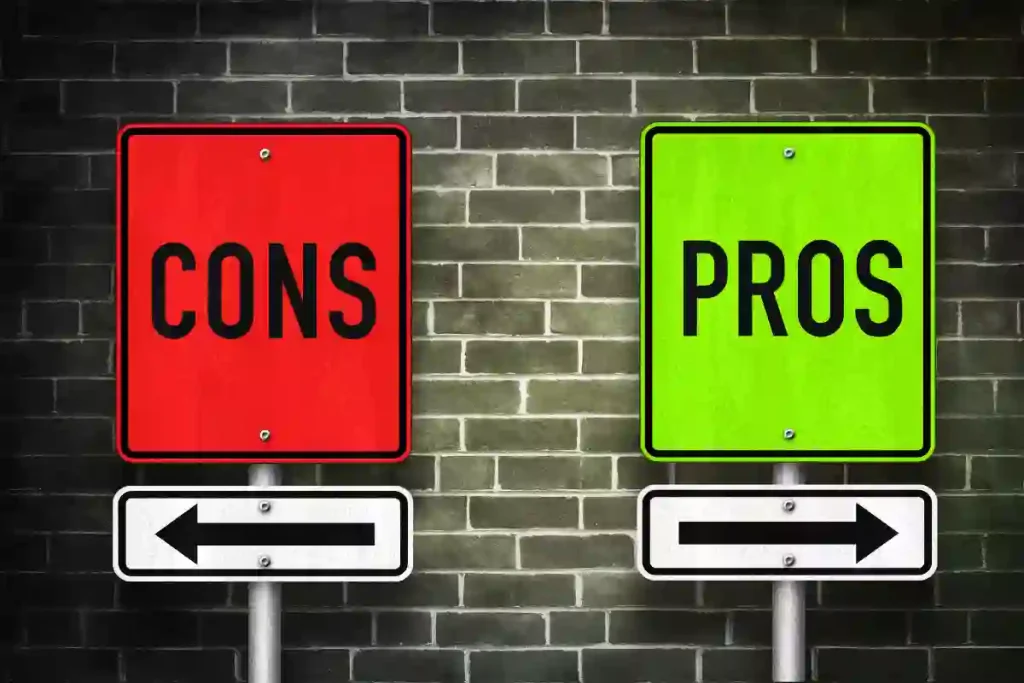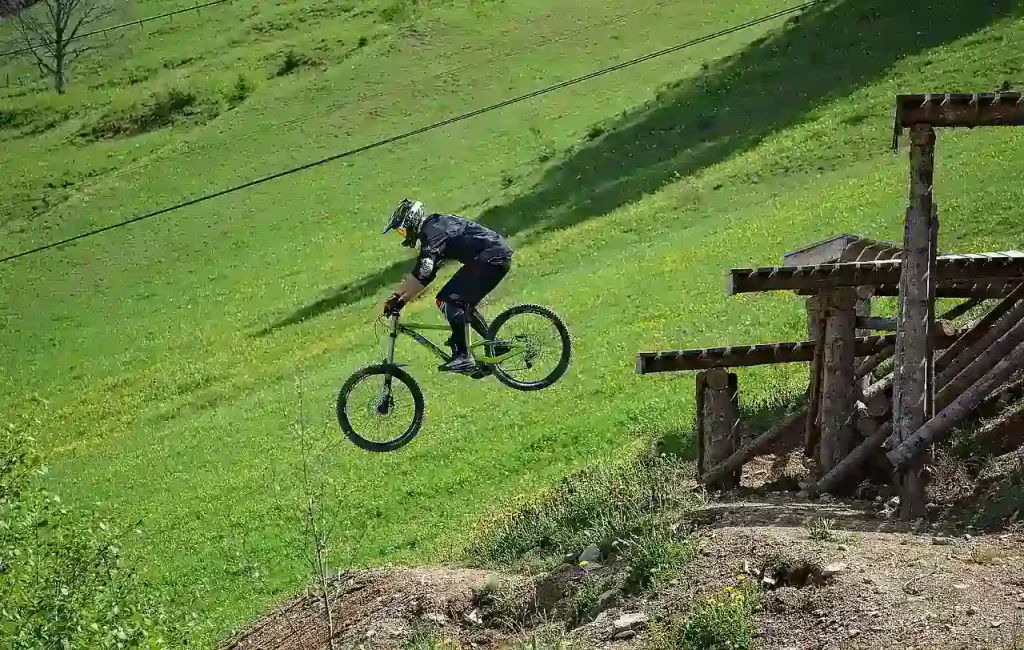Downhill bikes are worth it if you love riding down super steep and bumpy trails in places like bike parks. They’re made for crazy fast descents and tricky terrain. But here are a few things to think about before getting one:
First, they’re pretty expensive and need more looking after than regular bikes because they’re built for that extreme stuff. If you don’t ride these trails often, renting a downhill bike might be a smarter and cheaper choice.
Also, if you ride on different kinds of trails, not just super steep ones but also some easier ones, a different type of bike might be better. Some bikes can handle a mix of trails, so they’re more versatile.
So, downhill bikes are awesome if you’re really into extreme downhill rides, but they might not be the best fit for everyone because of the cost and the specialized way they’re made.
Downhill bikes are perfect for super steep and rough trails, like the ones in bike parks. They’re like superheroes for these tracks because they give you control even when going crazy fast downhill.
These bikes are built to handle bumpy trails smoothly, making your ride comfy no matter how rough it gets.
They’re super fast and let you zoom down while still being able to steer and handle the bike well on tricky paths. Plus, they’re tough and safe with strong frames and brakes.
Riding a downhill bike can also make you a pro at handling tough trails, which can help you become better at all kinds of mountain biking challenges.
Just remember, they’re amazing for extreme rides, but if you want to ride on different kinds of trails, they might not be the best choice since they’re specially made for downhill adventures!
Understanding the Value of Downhill Bikes
Downhill bikes are purpose-built machines tailored for conquering steep descents and rugged trails.
These specialized bikes boast sturdy frames, advanced suspension systems, and powerful brakes, ensuring stability and control on challenging terrains.
As a beginner, understanding their value lies in comprehending their purpose: excelling in downhill riding. These bikes offer precision handling, crucial for navigating sharp corners and obstacles while descending.
Their value becomes evident for riders seeking adrenaline-packed adventures and pushing their limits on technical descents.
The tailored design and performance attributes make downhill bikes invaluable in conquering challenging trails with confidence.
However, beginners should weigh the investment against their riding aspirations and frequency of use, as they might be more suited for dedicated downhill enthusiasts.
Pros and Cons of Investing in a Downhill Bike

Pros
Performance Excellence: Downhill bikes are unparalleled in downhill environments, ensuring stability and control on challenging terrains.
Specialized Design: Tailored with robust frames, advanced suspensions, and powerful brakes, they guarantee enhanced safety and handling.
Adrenaline Rush: Ideal for thrill-seekers craving high-speed, technical descents, offering an exhilarating riding experience.
Cons
Costly Investment: Downhill bikes tend to be expensive due to their specialized construction and components.
Limited Versatility: These bikes excel in downhill riding but might not perform well on other terrains.
Maintenance Intensive: They require meticulous upkeep and maintenance due to their complex components and rigorous usage.
Long-Term Benefits of Downhill Bikes
Beyond immediate thrills, downhill bikes offer durability, skill enhancement, and personal satisfaction.
Their sturdy build and high-quality components ensure longevity, enhancing riders’ skills in handling technical descents and providing immense joy in conquering challenging trails.
The worth of investing in a downhill bike depends on individual riding goals and commitment to the sport, considering the balance between performance, cost, and specialized use.
Exploring the Cost-Effectiveness of Downhill Bikes

Delving into the world of downhill biking prompts a crucial inquiry: do these specialized bikes truly offer cost-effectiveness? Cost-effectiveness in the realm of downhill bikes extends beyond the initial price tag.
These machines, meticulously engineered for extreme descents, boast specialized features and top-tier components. While the upfront investment might appear substantial, their durability, specialized design, and outstanding performance on steep terrains contribute significantly to their long-term value.
For beginners stepping into the domain of downhill biking, the cost-effectiveness of these bikes hinges on their commitment to conquering challenging trails.
Consider the frequency and intensity of downhill rides; if these thrilling descents form a substantial part of your biking escapades, the investment in a purpose-built downhill bike could indeed yield cost-effectiveness over time, offering unmatched performance and longevity.
Factors to Consider: Is a Downhill Bike Worth Buying?

Before diving headlong into purchasing a downhill bike, several crucial factors warrant consideration. Begin by scrutinizing your riding objectives.
If conquering treacherous descents and seeking exhilarating challenges align with your biking pursuits, a downhill bike holds immense value.
Assess the predominant terrain. Are your regular routes characterized by steep descents and technical trails? In such cases, the specialized design and performance attributes of a downhill bike become pivotal.
However, for riders exploring diverse terrains or seeking a versatile ride, the limitations of a downhill bike outside of downhill settings might pose a concern.
Financial considerations are paramount. Downhill bikes, owing to their specialized construction and high-end components, come with a considerable price tag.
Evaluate your budget and determine if the investment aligns harmoniously with your biking aspirations and financial capacities.
Assessing the Worth: Downhill Bikes vs. Other Options
The critical comparison emerges: when contemplating a downhill bike, how do they measure against alternative biking options? It’s imperative to weigh the worth of a downhill bike against other biking alternatives.
Consider all-purpose mountain bikes, which offer versatility across terrains but might lack the specialized prowess for extreme descents characteristic of downhill bikes.
Trail bikes strike a balance between downhill capability and versatility, catering to a broader spectrum of terrains.
Meanwhile, cross-country bikes prioritize endurance and agility, suitable for various terrains but potentially lacking the downhill performance seen in specialized downhill bikes.
Assessing the worth of a downhill bike involves careful consideration of individual preferences, riding aspirations, and intended terrains.
While these bikes deliver unparalleled performance in specific environments, riders must meticulously evaluate their biking goals and riding preferences across diverse terrains to determine if the specialized features align with their needs.
Real-World Worth: Downhill Bikes in Action

Downhill bikes are built for adrenaline-fueled adventures, designed to conquer the most challenging terrains.
Picture yourself navigating steep descents with a bike that boasts a robust frame, cutting-edge suspension, and powerful brakes.
These bikes excel on rugged trails, providing stability and control crucial for tackling obstacles with confidence.
Their real-world value lies in the thrill-seeking experience they offer, making them ideal for riders passionate about aggressive downhill riding.
They shine brightest on technical trails and steep descents, where their optimized performance and safety features truly come alive.
It’s like having a specialized tool for conquering extreme conditions, enhancing the adventure, and ensuring an exhilarating ride.
Making the Decision: Should You Invest in a Downhill Bike?
Deciding whether to invest in a downhill bike depends on your riding preferences and terrain choices.
If you’re keen on conquering extreme descents and technical trails, a downhill bike is unparalleled.
However, for those seeking versatility across various terrains, the specialized nature of downhill bikes might limit their utility.
Financial considerations, including initial costs and maintenance, play a crucial role.
Evaluating your biking aspirations and commitment to downhill riding helps determine if a downhill bike aligns with your needs and passion for extreme terrain conquering.
Are Downhill Bikes a Smart Purchase?

For dedicated downhill enthusiasts seeking optimized performance and control on extreme terrains, downhill bikes are a smart investment.
Their precision engineering and specialized design cater perfectly to aggressive downhill rides, ensuring stability and control in the most demanding conditions.
Downhill bikes may not be suitable for riders who want to ride on different terrains or casually.
Analyzing costs, maintenance, and compatibility with your riding goals is essential in assessing whether a downhill bike is a wise purchase for your biking endeavors.
Read more: Can Downhill Bikes Go Uphill?
Calculating the Value: Downhill Bikes and Your Investment
Investing in a downhill bike involves a thoughtful analysis of its worth concerning your biking preferences. While these bikes excel on steep descents and technical trails, their specialized nature might limit versatility across various terrains.
Consider renting a downhill bike initially to gauge its compatibility with your riding preferences and evaluate the financial commitment, including the initial cost and maintenance.
Reflect on your passion for aggressive downhill riding and commitment to conquering challenging trails to calculate the value a downhill bike brings to your biking journey.
Considering the Value Proposition of Downhill Bikes

Downhill bikes are designed for extreme terrains, offering stability and control crucial for conquering treacherous descents.
They cater to thrill-seekers passionate about aggressive downhill riding. However, their limited adaptability across diverse terrains might not suit riders seeking versatility.
Considering factors like rental options, cost, terrain preferences, and commitment to extreme terrain riding helps understand the value proposition of downhill bikes.
Evaluating the Worth: Downhill Bikes from a Practical Perspective
Assessing the worth of a downhill bike involves weighing its specialized performance against potential limitations in versatility.
These bikes offer unparalleled performance and control on extreme terrains for dedicated downhill enthusiasts.
Yet, for those exploring diverse terrains or seeking versatility, the specialized nature of downhill bikes might limit their utility.
Evaluating the initial cost, maintenance requirements, and alignment with your riding goals aids in determining the practical worth of a downhill bike.
Deciding If a Downhill Bike Is a Good Buy

Deciding on the suitability of a downhill bike as a purchase hinges on aligning its features with your riding goals and terrain preferences.
For dedicated downhill enthusiasts, a downhill bike represents a valuable investment. However, for riders seeking versatility across various terrains or casual riding scenarios, the specialized nature of these bikes might pose limitations.
Analyzing factors like cost, adaptability, and commitment to aggressive terrain riding helps in determining whether a downhill bike is a worthwhile purchase for your biking pursuits.
A well-maintained downhill bike can last anywhere between 3 to 5 years with frequent cleaning and maintenance.
What to look for when buying a downhill bike?
When purchasing a downhill bike, consider features like a long wheelbase, robust suspension, quality frame material, suitable suspension travel, and reliable braking systems.
How do I choose a downhill bike?
Choose a downhill bike based on factors such as the bike’s geometry, suspension system, frame material, wheel size, components’ quality, and intended use on steep terrains.
Which gear is best for the downhill bike?
Downhill bikes usually come equipped with a single gear as they’re specialized for steep descents and don’t require multiple gears. They often have a single chainring and a wide-range cassette to accommodate varying terrains.
Which bike is better for hills?
Downhill bikes are specifically designed for descending steep hills with aggressive terrain, offering superior suspension, stability, and control compared to other types of bikes.
What size wheel is best for the downhill bike?
Downhill bikes commonly use 27.5-inch wheels due to their agility, strength, and ability to navigate technical terrain while offering good rollover capabilities.
How do you know if a bike is good or not?
A good bike meets your specific needs, has a sturdy frame, reliable components, smooth operation, appropriate fit, and handles well on intended terrains. Consider factors such as build quality, comfort, and intended use to determine a bike’s suitability.

